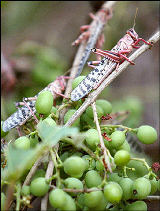Locust plague could sound death knell for north and west Africa
DAKAR, July 19 (AFP) — In an invasion of north and west Africa that may take on biblical proportions, locusts are swarming across the Sahara desert to threaten the yields from crops already wizened by years of drought in many of the world’s poorest countries.

Without immediate attention to the plague of locusts, FAO warned, entire fields of maize, cassava and other staple crops for the region will be razed to the ground by the pests’ insatiable appetites.
The swarms, which can devour in a twinkling enough food to feed 2,500 people, could make their way across west Africa into Niger, Chad and western Sudan, which is already facing a dire food shortage due to continued unrest in the Darfur region.
“It’s only just begun,” Ousseynou Diop of Senegal’s agriculture ministry told AFP, hearkening back to the last major locust invasions that hit Senegal in 1986 and 1993.
While Senegal suffered little crop damage in the past invasions, the country is not well-prepared to fend off the swarms, which are due to arrive at a particularly crucial time in the growing season.
“They used to come after harvest time, around November, but this year they are landing right in time for planting season,” he said. “They could devour everything, all of the seedlings — it could be a catastrophe.”
From 1987 to 1989, swarms of locusts stuffed themselves with what amounted to some 300 million dollars in damages to food production in north and west Africa, the FAO has said.
Swarm-watching has become a necessary, if repulsive, pastime for many farmers, who have spotted locusts chomping on maize and sorghum in eastern Senegal in the Bakel region, agriculture chief Mandian Waly has told local media.
Locusts have also had a field day in Algeria, devouring thousands of hectares of newly planted crops in recent weeks in the fertile zone that runs from Naama in the west to Tebessa in the east that separates the country’s north from the creeping Sahara desert.
Morocco has seen swarms engulf more than 100,000 hectares since late last month, while Mauritania’s pest control agency has reported that hoards of locusts have swarmed southwards through the massive northwest African country since early July, preparing to lay their eggs just as the rainy season arrives.
Though they normally favor the southern Sahara in their laying season, the locusts could return with a vengeance in September, Algeria’s Agriculture Minister Said Barkat told AFP, as their laying and hatching cycles are enhanced by the rains that are normally a boon to the dry region.
Locusts are impervious to treatment once they reach their chrysalis stage, Senegal’s Diop explained, so even the three million hectares across the Maghreb that have been treated with conventional pesticides to ward off the pests are vulnerable.
Results from field trials of biological pesticides, which are substantially less harmful to the environment and to human health, are still pending.
Senegal President Abdoulaye Wade has taken the lead in mounting a regional onslaught against the locust infestations, calling last week on the world’s most developed countries, the G8, to take up the battle against the pests.
Without urgent and sustained attention to the problem, he warned, the locusts could sound a death knell for millions of people in a region already plagued with rampant malnutrition.
